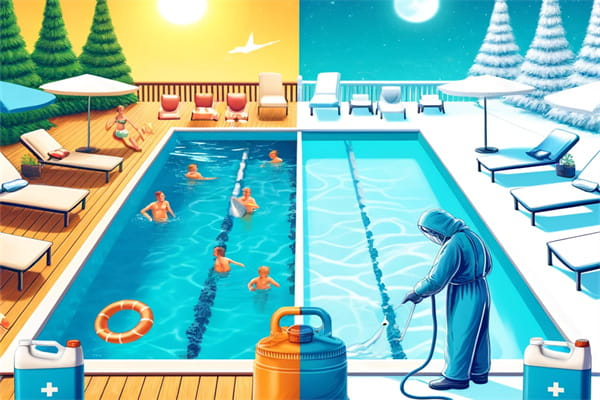Chlorine tablets are a convenient, reliable, cost-effective, and easy-to-use method of sanitizing pools, making them a preferred choice for many pool owners. Their slow-release nature means you can simply place them in a dispenser and let them work their magic. Compared to using chlorine granules or liquid, getting the dosage right is also more straightforward, as you don’t need to perform any precise measurements. The key question, however, is how many tablets you need based on the size and requirements of your pool.

Ⅰ. What Size Chlorine Tablets Do I Need?
You will encounter two main sizes of chlorine tablets:
- 20g Chlorine Tablets (1-inch diameter)
- 200g Chlorine Tablets (3-inch diameter)
Smaller tablets are most commonly used in hot tubs and small above-ground pools, while the larger tablets are better suited for most swimming pools.
Ⅱ. Basic Guidelines
1.Understanding Chlorine Tablets:
Chlorine tablets are designed to slowly dissolve and release chlorine into your pool over time. This slow release helps maintain a consistent chlorine level, which is essential for keeping the water clean and free from harmful bacteria and algae.
2.Dosage Based on Pool Size:
As a general rule, you should use one 3-inch chlorine tablet for every 5,000 gallons of pool water. Here’s a quick reference guide:
- 5,000 gallons: 1 tablet
- 10,000 gallons: 2 tablets
- 15,000 gallons: 3 tablets
- 20,000 gallons: 4 tablets
By following this guideline, you can ensure that your pool maintains the proper chlorine levels needed to keep the water clean and safe.
Ⅲ. Importance of Correct Dosage
Ensuring the correct dosage of chlorine tablets in your pool is critical to maintaining a healthy and enjoyable swimming environment. Let’s delve into why it’s essential to avoid both under-chlorination and over-chlorination.
1.Avoiding Under-Chlorination:
Under-chlorination occurs when you use too few chlorine tablets, resulting in chlorine levels that are too low to effectively sanitize the pool. This can have several negative consequences:
- Bacterial Growth: Low chlorine levels are insufficient to kill bacteria and other harmful microorganisms. This can lead to infections and illnesses among swimmers.
- Algae Bloom: Without adequate chlorine, algae can quickly take over your pool, turning the water green and making surfaces slippery and unsightly.
- Unpleasant Odors: Insufficient chlorine allows organic matter to build up, leading to unpleasant smells emanating from the pool.
- Cloudy Water: Low chlorine levels can cause the water to become cloudy and murky, reducing visibility and making the pool less inviting.
Maintaining proper chlorine levels ensures that your pool remains safe, clear, and pleasant to swim in. Regularly testing the water and adjusting the dosage as needed helps prevent under-chlorination.
2.Avoiding Over-Chlorination:
Conversely, using too many chlorine tablets can lead to over-chlorination, which also poses several issues:
- Health Irritations: High chlorine levels can cause skin and eye irritation among swimmers. Symptoms may include red, itchy skin and stinging eyes.
- Respiratory Problems: Excess chlorine can release strong fumes that may cause respiratory discomfort or exacerbate conditions such as asthma.
- Damage to Pool Equipment: Over-chlorination can be harsh on pool equipment and surfaces. Chlorine can corrode metal parts, damage pool liners, and degrade plastic components, leading to costly repairs or replacements.
- Bleaching Effects: High chlorine levels can bleach swimsuits, pool toys, and even hair, causing discoloration and damage.
Striking the right balance is essential to maintaining a healthy swimming environment. Over-chlorination not only affects the physical comfort of swimmers but also the longevity of your pool infrastructure.
Ⅳ. Seasonal Adjustments
1.Summer vs. Winter Maintenance:
The amount of chlorine your pool needs can vary with the seasons. During the summer, higher temperatures and increased pool usage typically require more chlorine. In contrast, during the winter, when the pool is used less and the water temperature is lower, you can reduce the amount of chlorine used.

2.Adjusting for Seasonal Weather Changes:
Hot, sunny days can cause chlorine to dissipate more quickly due to UV exposure, requiring more frequent additions of chlorine tablets. Rainy weather can dilute the pool water, lowering the chlorine concentration. Adjusting the chlorine dosage based on these seasonal weather patterns can help maintain the optimal chlorine levels in your pool.
Ⅴ. Conclusion
Determining the right number of chlorine tablets to use in your pool is essential for keeping the water clean and safe for swimming. While the general guideline is to use one 3-inch tablet for every 5,000 gallons of water, factors such as pool size, correct dosage, and seasonal adjustments can influence this amount. Regular testing of your pool water and adjusting your maintenance routine based on these factors will help ensure your pool remains in top condition.

 Instant
Quote
Instant
Quote Email
Us
Email
Us